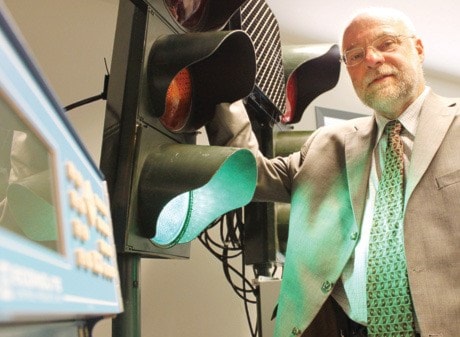If it wasn’t for a computer glitch, Victoria transit buses could be saving valuable time shuttling people along Douglas Street.
Twenty-two traffic lights from Belleville Street to Uptown feature a high-tech ability to allow approaching buses to make it through intersections faster. There’s one problem: part of the system isn’t functioning.
“We’re not sure if it’s a hardware or software issue,” said Dwayne Kalynchuk, Victoria’s director of engineering and public works. “As soon as we find the glitch, we’ll implement the balance of the system.”
Detectors at each intersection pick up the global positioning service signal automatically relayed by buses travelling Douglas Street. That signal can extend a green light or shorten a red light by eight seconds.
When city staff tried to get the technology up and running four weeks ago, it discovered a malfunction was plaguing one of two types of controllers installed at an unknown number of traffic lights.
“Before we put it into operation on the road, we wanted to make sure everything was okay,” Kalynchuk said,
While waiting for the technology supplier, California-based company Econolite, to fix the problem over the next six to eight weeks, the city is piloting the queue-jumper technology at three intersections along Douglas Street at Fisgard and Harold streets and Caledonia Avenue.
It’s the first time the $2.9-million transit priority signal system, funded by a provincial infrastructure grant in 2005, has been used since its installation in 2009.
Why it has taken so long is unclear.
B.C. Transit staff were not available to explain the delay but the company’s public relations manager, Joanna Linsangan, said, “Rest assured, B.C. Transit is working with the City of Victoria to move this project forward.”
“Certainly it’s taken longer than anticipated and what the delay’s been I (don’t know),” said Kalynchuk. “I’m not going to point fingers it was them or us as much as we’re working together on a team to get this operational as quickly as we can.
“Transit had to provide certain information to us to move forward, and I think there was just additional time required for the project.”
The technology is one option B.C. Transit could use to improve its bus service while the region waits for light rail.
The Victoria Regional Transit Commission recently asked B.C. Transit to explore ways of moving people faster, especially along busy Douglas Street.
In addition to the transit signalling system, high-occupancy vehicle or carpool lanes during peak traffic hours might be another option, said Victoria Mayor Dean Fortin.
“You need a system that’s reliable,” he said.
emccracken@vicnews.com
